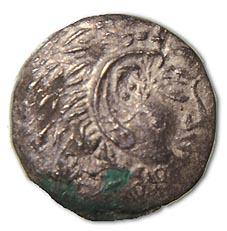Coin Discovery at ed-Dur Suggests a Female Ruler
Noah Wiener
Source - http://www.biblicalarchaeology.org/daily/ancient-cultures/ancient-near-eastern-world/coin-discovery-at-ed-dur-suggest-a-female-ruler/

An "Abi'el" coin, showing Heracles wearing the head of the Nemean lion as a hood.
Surveys at ed-Dur, a prominent multi-period site in the United Arab Emirates, exposed numerous coins. While some may have come from as far as Rome, coins minted locally include the name “Abi’el, the daughter of so and so” written in Aramaic, according to a recent report in the UAE’s international, English-language newspaper The National. The Hellenized coins, featuring depictions of Heracles and a god thought to be Zeus or a sun god, are the earliest known coins from the Emirates. Ed-Dur was an important trade center between Mesopotamia and India, and the proposed UNESCO World Heritage site includes important finds from as early as 3,000 B.C.E. The site flourished between 200 B.C.E. and 300 C.E., and features a prominent first-century C.E. temple to a sun god, including sacrificial altars, ashlar masonry and a basin with the Aramaic word “Shamash,” the name of the sun god that is closely tied to the Arabic word Shams, meaning sun. The National reports that more than “118 copper or silver coins of different shapes and sizes were found at ed-Dur. They follow to some degree the ancient Greek Attic weight standard of obols (a denomination of less than one gram), drachmas (4-5g) and tetradrachms (14-17g).” The locally minted coins provide a new insight into the understudied pre-Islamic administration. Abi’el is frequently invoked on coinage in a wide spread of sites over several centuries, suggesting that there were either multiple rulers called Abi’el, or that the coinage was copied for several centuries.
Was ed-Dur ruled by a woman?
Rym Ghazal
Source - http://www.thenational.ae/news/uae-news/heritage/was-ed-dur-ruled-by-a-woman
Images on a coin can tell the story of place and time.
But for some of the coins found at ed-Dur, it is a name that is causing the greatest debate.
“It is a real mystery,” says Dr Ernie Haerinck. “The coins minted locally have a name added to them in Aramaic. It is ‘Abi’el’, the daughter of so and so.
“Perhaps ed-Dur was a kingdom run by a woman?”
The name was added to “imitations of imitations” of common coins, attributed to the first century AD.
These feature the head of Heracles, or Hercules, wearing the pelt of the Nemean lion on the obverse (with a dot like a wart on his cheek) and on the reverse an enthroned, partially nude male figure or god (Zeus or a sun-god), with a horse or horse-protome, rather than the more common eagle, printed on its outstretched arm.
There is also a three-fluked anchor or trident and palm tree depicted on some coins, linking them to the sun god, as palm wood or branches were burnt around the ed-Dur temple.
The horse also has associations with the sun god, giving further evidence to the site’s Shams/Shamash-cult past.
More than 118 copper or silver coins of different shapes and sizes were found at ed-Dur. They follow to some degree the ancient Greek Attic weight standard of obols (a denomination of less than one gram), drachmas (4-5g) and tetradrachms (14-17g).
“One of the biggest problems we have is that a lot of the pre-Islamic rituals and histories have not been noted down anywhere, and the fact that we have less and less specialists around who can read Aramaic and its different ancient dialects,” says Dr Haerinck.
Besides locally minted coins, which offer proof of autonomy and political and economic independence, there are many unexplained discoveries at ed-Dur, one that led Dr Haerinck to say: “Maybe there were pirates here?
“For the vastness of what has been found here could be explained through one theory and texts by Romans about this area, that just maybe some ed-Dur pirates brought back lots of plunder and treasures from across the world.”